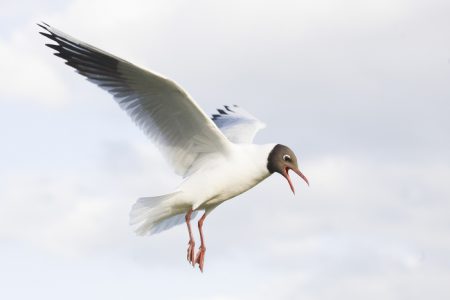Chroicocephalus ridibundus
Family: Laridae
Length: 35 – 45 cm
Wingspan: 94 – 110 cm
Weight: 190 – 400 g

Identification
Appearance: white with pearl-grey wings with black tips, dark brown head (except in winter: white with a blackish patch behind the eye) with a orange-dark red bill and orange legs.
Distinguishing characteristics: black tips to the primary feathers and slighter bill than the Mediterranean gull.
Flight: fast and active, but can glide gracefully in air currents.
Sound: very rich vocal repertoire, with a familiar « kree-ar » call.
Ecology and habitat
Nest: a simple depression or mound of plant in large reed beds or marshes, or on islands in lakes.
Diet: feeds on crabs, molluscs, eels, insects such as flying ants, earthworms and various detritus.
Behaviour at sea: dives to catch fish by following fishing boats; not a pelagic species and is rarely seen at sea far from coasts.
* This map indicates coastal nesting sites in the Mediterranean and adjacent Seas.
Distribution and movement
Breeding: across in much of Europe and Asia, and in coastal eastern Canada.
Wintering: sedentary in the Mediterranean; mostly migratory otherwise.
Phenology: Laying end-April / early May; two to four eggs. Incubation: 22 – 26 days. Fledging: 32 – 35 days after hatching.
Conservation
Global population estimate: European population estimated at 1,340,000 – 1,990,000 pairs
Threats: diseases (avian influenza , avian botulism), egg collecting, chemical pollutants.
Protection level: Barcelona Convention : Annex II; Bern Convention: Annex II; Birds Directive: Annex II; African Eurasian Waterbird Agreement; IUCN Red List: Least Concern.
Some key references
BirdLife International (2021) Species factsheet: Larus ridibundus.
